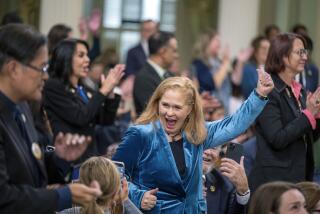A Chronology of Enron Corp.
A chronology of Enron Corp. and criminal cases emerging from its collapse:
1985 -- Houston Natural Gas merges with InterNorth to form Enron, HNG CEO Kenneth Lay becomes CEO of combined company the following year.
1989 -- Enron begins trading natural gas commodities.
1990 -- Lay hires Jeffrey Skilling to lead the company’s effort to focus on commodities trading in the deregulated markets. Andrew S. Fastow is one of Skilling’s first hires later that year.
1991 -- Richard Causey leaves Arthur Andersen LLP to join Enron as assistant controller.
1997 -- Skilling named president and chief operating officer of Enron. Fastow creates Chewco, a partnership, to buy the University of California pension fund’s stake in another joint venture dubbed JEDI, but Chewco doesn’t meet requirements to be kept off Enron’s balance sheet. First step toward similar financial moves to hide debt and inflate profits that fuel Enron’s downfall.
1998 -- Fastow named finance chief.
1999_ Causey named chief accounting officer. Fastow creates the first of two partnerships, LJM, purported to “buy” poorly performing Enron assets and hedge risky investments but really helps the company hide debt and inflate profits. Enron directors approve Fastow’s plan that he run the partnerships that do deals with Enron while continuing as Enron’s finance chief. Causey and former chief risk officer Rick Buy assigned to monitor such deals to protect Enron’s interests.
August 2000 -- Enron shares reach high of $90.
December 2000 -- Enron announces that Skilling, then president and chief operating officer, will succeed Kenneth Lay as CEO in February 2001. Lay will remain as chairman. 2001:
Aug. 14 -- Skilling resigns; Lay named CEO again.
Aug. 22 -- Finance executive Sherron Watkins meets privately with Lay to discuss concerns of murky finance and accounting that could ruin the company.
Oct. 16 -- Enron announces $638 million in third-quarter losses and a $1.2 billion reduction in shareholder equity stemming from writeoffs related to failed broadband and water trading ventures as well as unwinding of so-called Raptors, or fragile entities backed by falling Enron stock created to hedge inflated asset values and keep hundreds of millions of dollars in debt off the energy company’s books.
Oct. 19 -- Securities and Exchange Commission launches inquiry into Enron finances.
Oct. 22 -- Enron acknowledges SEC inquiry into a possible conflict of interest related to the company’s dealings with Fastow’s partnerships. Lay says, “We will cooperate fully with the SEC and look forward to the opportunity to put any concern about these transactions to rest.”
Oct. 23 -- Lay professes confidence in Fastow to analysts.
Oct. 24 -- Fastow ousted.
Nov. 5 -- Enron treasurer Ben Glisan Jr. and in-house attorney Kristina Mordaunt fired for investing in Fastow-run partnership. Each invested $5,800 in 2001 and received a $1 million return a few weeks later.
Nov. 8 -- Enron files documents with SEC revising its financial statements for previous five years to account for $586 million in losses.
Nov. 9 -- Dynegy Inc. announces an agreement to buy Enron for more than $8 billion in stock.
Nov. 19 -- Enron restates its third-quarter earnings and discloses a $690 million debt is due Nov. 27.
Nov. 28 -- Enron stock plunges below $1 as Dynegy Inc. aborts its plan to buy its former rival.
Dec. 2 -- Enron goes bankrupt, thousands of workers laid off.
2002:
Jan. 9 -- Justice Department confirms it has begun a criminal investigation of Enron.
Jan. 10 -- The White House discloses Lay sought help from two Cabinet members shortly before the company collapsed, but neither offered aid. The company’s auditor, Arthur Andersen LLP, says it has destroyed tons of Enron documents.
Jan. 23 -- Lay resigns as chairman and CEO.
Jan. 25 -- Cliff Baxter, former head of Enron’s trading unit and later vice president before his resignation in May 2001, found dead of a self-inflicted gunshot wound.
Feb. 4 -- Lay resigns from the board.
Feb. 7 -- Skilling, Fastow, Michael Kopper appear at Congress with McMahon and in-house Enron lawyer Jordan Mintz. Skilling testifies; Fastow and Kopper invoke Fifth Amendment rights.
Feb. 12 -- Lay invokes Fifth Amendment at a Senate hearing after expressing “profound sadness” at Enron’s collapse.
March 14 -- Former Enron auditor Arthur Andersen LLP indicted for destroying Enron-related documents to thwart investigators.
April 9 -- David Duncan, Andersen’s former top Enron auditor, pleads guilty to obstruction for instructing his staff to destroy documents as per company policy.
June 15 -- Andersen convicted.
Aug. 21 -- Former top Fastow aide Michael Kopper pleads guilty to money laundering and conspiracy, the first ex-Enron executive to strike a deal with prosecutors. He identifies a string of partnerships designed to falsely portray Enron as financially healthy while enriching him, Fastow and others.
Sept. 12 -- Three former National Westminster Bank bankers indicted for wire fraud for siphoning off millions of dollars in income intended for their employer through investments in a Fastow partnership. They are fighting extradition.
Oct. 16 -- Andersen sentenced to probation and fined $500,000; firm was already banned from auditing public companies and had only a few hundred employees left after its conviction.
Oct. 17 -- Former top Enron trader Timothy Belden pleads guilty to wire fraud for participating in schemes to game California’s power markets during the state’s energy crisis in 2000 and 2001.
Oct. 31 -- Fastow indicted on 78 charges of conspiracy, fraud, money laundering and other counts.
Nov. 26 -- Former midlevel executive Larry Lawyer pleads guilty to filing false tax forms for failing to report as income nearly $80,000 in “gifts” Kopper funneled to him for his work on a shady Fastow transaction.
2003:
Feb. 4 -- Former Enron trader Jeffrey Richter pleads guilty to conspiracy and lying to the FBI for helping manipulate California’s electricity market in 2000.
March 12 -- Indictment unsealed against two former Enron Broadband finance and accounting executives, Kevin Howard and Michael Krautz, on charges of faking $111 million in earnings from a failed video-on-demand deal with Blockbuster.
April 30 -- Counts against Fastow increased to 98, while his wife Lea is charged with tax crimes and conspiracy for participating in some of husband’s deals. Five other former broadband executives charged with lying to Wall Street and investors about capabilities of Enron’s broadband network to inflate company stock. Former Enron treasurer Ben Glisan Jr. charged with conspiracy and money laundering for participating in Fastow-controlled deals. Former finance executive Dan Boyle charged with conspiracy for his role in pushing through Enron’s sham sale of power plants mounted on barges near Nigeria to Merrill Lynch & Co. to help the energy company appear to have met earnings targets.
Sept. 10 -- Glisan pleads guilty to conspiracy and goes straight to prison for five years, becoming the first former Enron executive behind bars. Later begins cooperating with prosecutors.
Sept. 17 -- Indictments unsealed against three former Merrill Lynch bankers for their roles in the Nigerian barge deal. A fourth former Merrill Lynch executive and a former in-house Enron accountant later charged in the same deal.
Oct. 30 -- David Delainey, a former chief executive of Enron’s trading unit, pleads guilty to one count of insider trading, acknowledging he was in on a “senior management” scheme to manipulate the company’s earnings to meet or exceed Wall Street’s expectations while selling $4.2 million in stock.
2004:
Jan. 14 -- Andrew Fastow pleads guilty to two counts of conspiracy and agrees to serve 10 years in prison after prosecutors no longer need his cooperation.
Jan. 22 -- Former top Enron accountant Richard Causey pleads innocent to conspiracy and fraud charges for allegedly being “a principal architect” of widespread schemes to mislead investors in the scandal-ridden energy company.
Feb. 19 -- Skilling added to Causey indictment, pleads innocent to more than 30 counts including conspiracy, fraud and insider trading. Indictment expanded to push counts against Causey past 30 as well.
May 6 -- Lea Fastow pleads guilty to a reduced charge of filing a false tax form, a misdemeanor, and is sentenced to the maximum sentence of one year in prison.
May 19 -- Former Enron corporate secretary Paula Rieker pleads guilty to one count of insider trading for selling stock in July 5 knowing Enron’s broadband unit lost more money than publicly claimed.
July 7 -- Sealed indictment against Lay handed up.
July 8 -- Lay surrenders to FBI. Indictment unsealed, accusing him of participating in a conspiracy to manipulate Enron’s quarterly financial results, making false and misleading public statements about the company’s financial performance and omitting facts necessary to make financial statements accurate and fair. Lay pleads innocent.
July 15 -- U.S. Bankruptcy Judge Arthur Gonzalez confirms Enron’s reorganization plan in which most creditors will receive about one-fifth of the the approximate $63 billion they’re owed in cash and stock.
July 30 -- Former Enron Broadband CEO Kenneth Rice pleads guilty to securities fraud, and forfeits $13.7 million in cash and property that includes jewelry and a pair of exotic sports cars.
Aug. 5 -- Former top Enron trader John Forney pleads guilty in San Francisco to manipulating energy prices during California’s power crisis in 2000-2001.
Aug. 25 -- Former Enron investor relations head Mark Koenig pleads guilty to aiding and abetting securities fraud. Koenig helped present falsified financial reports to investors.
Aug. 31 -- Former Enron Broadband chief operating officer Kevin Hannon pleads guilty to one count of conspiracy.
Sept. 20 -- Fraud and conspiracy trial of four former Merrill Lynch executives and two former midlevel Enron executives begins.
Oct. 7 -- Former Enron assistant treasurer Timothy Despain pleads guilty to conspiracy and agrees to cooperate with prosecutors.
Oct. 15 -- A British judge rules that three British bankers indicted in the United States on Enron-related fraud charges could be extradited to stand trial in Texas. They continue to fight the ruling.
Oct. 19 -- A federal judge grants Lay a trial separate from Skilling and Causey on charges of bank fraud and lying to banks about using loans to buy Enron stock on margin, but rules the trio will be tried together on other charges.
Nov. 3 -- Jurors convict four former Merrill Lynch & Co. executives, including former head of investment banking Daniel Bayly, and a former midlevel Enron Corp. finance executive of conspiracy and fraud in the barge case. A former in-house Enron accountant is acquitted.
2005:
Feb. 24 -- A federal judge schedules the Lay, Skilling and Causey trial for Jan. 17, 2006.
April 18 -- Enron broadband trial begins.
May 31 -- U.S. Supreme Court overturns former Andersen conviction, ruling unanimously that vague jury instructions allowed jurors to convict without finding criminal intent behind mass document destruction. The government said in November 2005 that prosecutors will not retry the firm, reduced to about 200 workers from 28,000 who mainly handle pending lawsuits.
July 15 -- Former Enron accounting executive Christopher Calger pleads guilty to conspiracy for participating in a scheme to recognize earnings prematurely and improperly.
July 20 -- Jury in Enron broadband trial acquits three of five defendants on some charges but deadlocks on most of the 164 counts. The five defendants will be retried on fewer counts in three separate trials in May, June and September of 2006.
Dec. 12 -- A judge approves David Duncan’s withdrawal of his guilty plea.
Dec. 28 -- Causey pleads guilty to securities fraud and agrees to serve seven years in prison in exchange for cooperating with the government.
2006:
Jan. 30 -- Lay, Skilling trial begins.
May 25 -- Lay and Skilling are convicted of conspiracy to commit securities and wire fraud in connection with Enron’s collapse. Lay is convicted in a separate bank fraud case.
More to Read
Start your day right
Sign up for Essential California for news, features and recommendations from the L.A. Times and beyond in your inbox six days a week.
You may occasionally receive promotional content from the Los Angeles Times.






